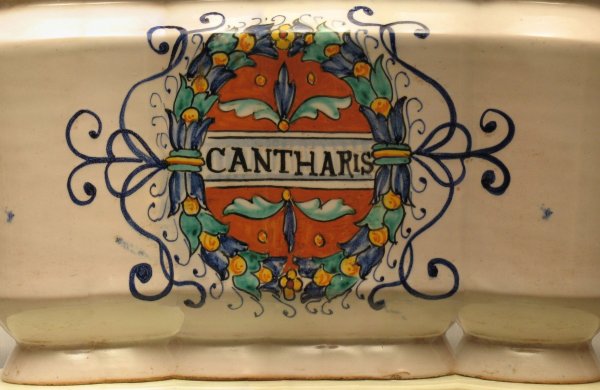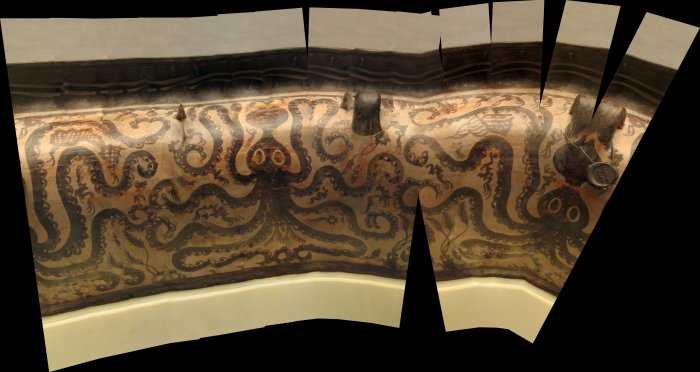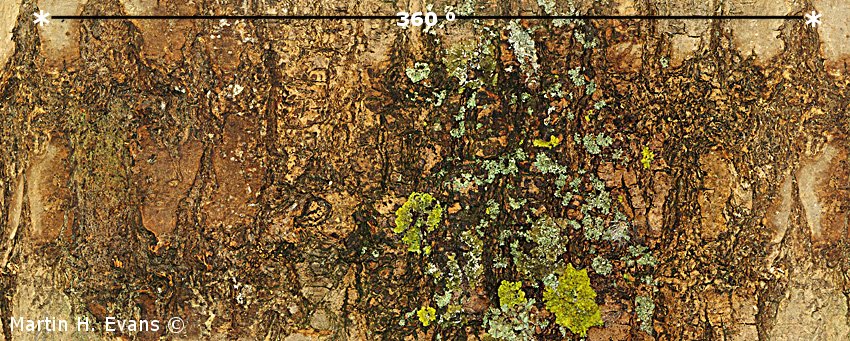Cameras designed to photograph the outer periphery of objects have been elaborate mechanical combinations of a rotating turntable on which the object is carried, coupled with a camera in which the photographic emulsion is moved in a linear direction, past a slit, synchronously with the rotation of the turntable. The process is sometimes called "rollout photography". It has been used in forensic work; for instance, to provide a two-dimensional image of the outside of some cylindrical object, such as a fired bullet to show the 'signature' scores left by a gun's rifling.
I find that it is possible to achieve a similar two-dimensional image by means of a standard digital camera, a simple turntable, and some readily accessible software. Even an inexpensive popular digital compact camera will produce reasonably good results. In the first examples shown below the images were captured on a simple Canon PowerShot A620 camera. The camera was used in aperture-priority mode (Av) at f/8.0. The built-in flash was enabled, but to get good overall illumination it was screened from the object with some kitchen foil and used solely to trigger a Vivitar 283 flashgun on a slave sensor, set to bounce the illumination off the ceiling. The camera flash was set to 'Manual' to synchronize the slave flash with the shutter in Av mode.

The camera was supported on a stable tripod and was carefully set to be horizontal. A domestic gramphone turntable, that had also been set to horizontal with a spirit level, was used to rotate the object for these tests. It had been marked off in 16 equal sectors (22.5 degree angles). The round objects were centered as accurately as possible, with the aid of a makeshift probe. This image shows the rough-and-ready arrangement.

These two objects were tried for these tests. One is a 20th century reproduction of an old apothecary jar, with a design extending around approximately three-quarters of the cylindrical periphery. The other pot is a modern museum reproduction of an ancient Cretan pot from the Knossos bronze-age site. It is decorated all the way around with octopus motifs, but is very far from being cylindrical.
When the test object had been centered, 16 or more ordinary digital images were taken. After each photograph the turntable was rotated by 1/16 of a turn, or 22.5 degrees, and the next photgraph taken.
Each set of 16 (or more) images was loaded into the computer and processed by a standard image-manipulation program. I happen to use Paintshop Pro version 7; most photographers will have a version of Photoshop on their computers. For these tests I simply cropped each successive image to a narrow vertical slice, slightly wider than the arc of the 22.5 degree turn, and almost the full height of the original image (about 2300 pixels in these images).
The 16 cropped images were then passed to a photo-stitching program. I found that Image Composite Editor (ICE.EXE), which can be downloaded free of charge from the Microsoft web-site, generally did a good straightforward job of merging the slices to produce a fairly good flat representation of the pattern on the cylindrical surface:

Some irregularity in the bases suggests that some of the slices were not properly merged. There is a little unevenness in the brightness - I think that I was not leaving the capacitor in the Vivitar 283 to charge fully, resulting in some inconsistency in illuminance.
I am quite pleased with this preliminary result on a decorated cylindrical object. If one rotated at smaller angles of arc - say 10 or even 5 degrees, took the appropriately larger number of photographs, and cropped these into even narrower strips, I think that the result would be professionally acceptable. Even the slight overlap of the decoration onto the upper rim has been handled successfully.
The octopus pot has been much less successful. The angular distortion due to the greatly varying diameters at different heights up this object made it impossible for the ICE program to merge them accurately. It has made a reasonable result from it, and the result is both amusing and does actually allow a partial two-dimensional appreciation of the decoration on the spheroidal surface:

---
The image below was created from 16 vertical 'slices' of the surface of a small log, merged by means of the ICE.EXE program. The primary photographs were taken with a Pentax K-x camera and Tamron SP90mm f/2.5 macro lens at f/8. In this example the best illumination was achieved by using the camera's inbuilt flash unit, which brought out the colour of the lichens growing on part of the bark. The asterisks indicate the full 360 degree circumference: about 43 cm.

Later notes and acknowledgements:
Justin Kerr was one of the pioneers in the use of moving film and a rotating turntable to create "rollout" images of archaeological and other vases in the 1970s. A short paper describing the history of his work is at the:
Foundation for the Advancement of MesoAmerican Studies, Inc.
Andrew Davidhazy wrote an article describing the use of a DSLR camera to create "rollout" images of the periphery of cylindrical or other round objects. It is at:
http://people.rit.edu/andpph/text-strip-rollout-DSLR.html
This technique involves swinging the camera through an arc while taking a long-exposure photograph of the object rotating behind a slit. It thus mimicks the 'rolling film past a slit' technique of pre-digital perimeter photography, and produces more satisfactory rectangular images of 'spheroidal' objects, which are reproduced in a Mercator-like projection.
Davidhazy has also described the use of a Model 593 memory unit to capture "slit-like" scans of a round object:
Peripheral Imaging with Electronic Memory Unit
In 2011 Ángel M. Felicísimo published a very detailed paper in
Technical Briefs in Historical Archaeology. A process similar to the one I have described above is covered in depth.
Martin H Evans, 6 January 2011, revised 29th January 2013, 4 November 2019. email: martineva 'at' waitrose.com (edit appropriately)